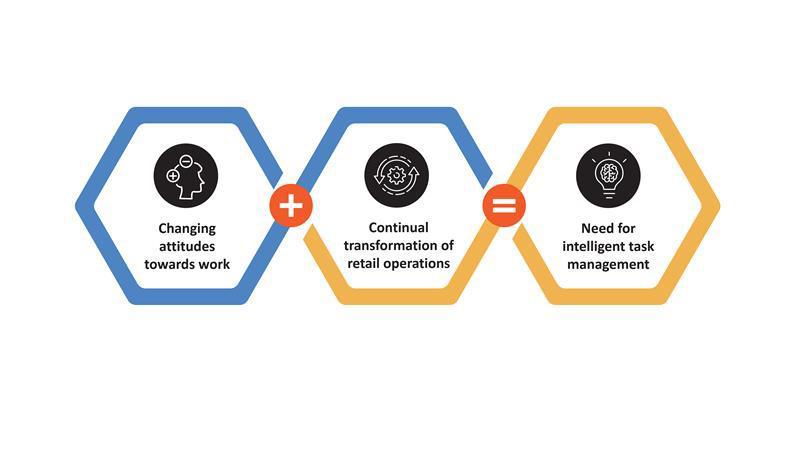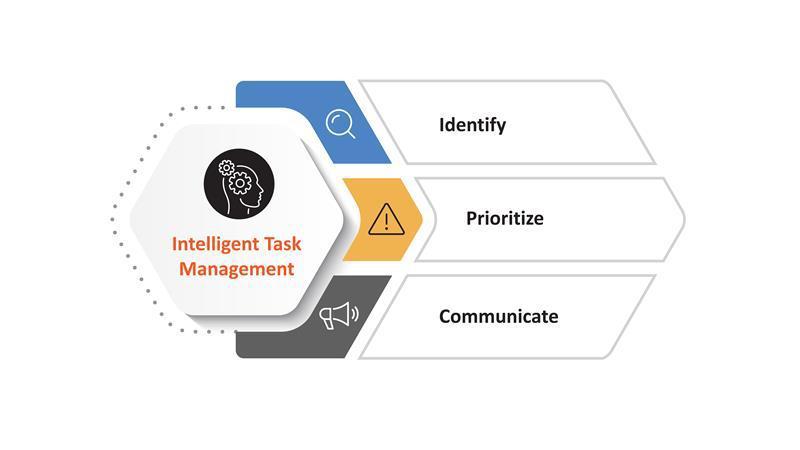Industry
HIGHLIGHTS
- Retailers are under pressure to keep prices low amidst rising costs, changing customer expectations, and the demand for flexibility from retail associates.
- Cost-cutting programs to simplify store operations are one of the main levers being pulled to achieve this but retailers risk creating incoherent operating models that are difficult to resource and manage.
- A different approach is needed to ensure operational coherence while achieving efficiencies and flexibility within the workforce.
On this page
The management challenge
Retailers are under tremendous pressure to keep prices low in a market that is fiercely competitive on price.
Rising global labor costs, regulatory changes, increasing costs of goods, inflation, and the cost-of-living crisis are all adding to the cost pressures facing retailers. To combat these increased costs, commercial negotiations (to ensure prices remain low for customers) are tougher than ever and we’re seeing a huge uplift in supplier branded in-store marketing to try and improve margins, while cost-cutting initiatives are looking to reduce the operating costs across the value chain. In stores, these initiatives strain already tight labor budgets, often through management restructures and so-called 'process efficiencies' that provide minimal real improvements, therefore just tasking stores to achieve the same with less.
Operational processes in retail are well documented through standard operating procedures (SOPs) or operating models, showing what should be done to run the store and how to do it—be it the daily activities that are the heartbeat of the operation, such as checkouts, replenishment, and inventory management, or less frequent activities that ensure smooth operations or offer the chance to reset store standards, such as audits, merchandising changes, and training. . There are also tasks that seem to have no regular cadence that are often communicated on an ad-hoc basis–project implementation, product recalls, and other one-off activities (or 'fires' that need to be dealt with). Management teams are charged with ensuring these activities get completed, while balancing the many key performance indicators (KPIs) that they are also accountable to deliver.
Although these processes are documented, they do not account for the day-to-day surprises that can have a huge impact on how a store actually works; they often only explain how to perform each activity in isolation and in a perfect world. Unexpected absence, late deliveries, chiller breakdowns, technology issues, or a whole host of other problems that crop up on a daily basis can derail the SOP in an instant and management teams must make decisions on how to reprioritize activities to maintain the delicate balance of delivering the numbers, while providing an excellent shopping experience for customers.
Management teams excel at balancing priorities and making judgment calls to keep operations running. This is the basic essence of task management. The issue is that no matter the capability level of the management teams, it is likely that no two managers would make the same decisions or prioritize the same things. This means execution across stores, or even within the same store across different days, can be wildly inconsistent and we can never be sure that we’re delivering the best outcomes given the specific circumstances.
The need for change
The constantly changing landscape of retail outlined above is, of course, a major factor driving the need to rethink how store operations are managed.
When reimagining the store operation, there are key additional factors to consider. These factors—that have accelerated drastically over the last five or so years—are changing attitudes towards work and the transformation of retail store operations (Figure 1).
- Changing attitudes towards work: It is no surprise that the expectations of the workforce are changing. Recent years have seen a significant shift in how people approach work, with flexibility and purpose becoming core expectations. Remote and hybrid working is now the norm for many–not necessarily an option for those who work in retail stores, but the demand for flexible working is steadily increasing. Flexibility will become essential to help employees balance work with personal commitments. Workers are also starting to seek greater alignment to their purpose through their jobs, and this will make variety and multi-skilling increasingly important. This manifests in several ways; from workers seeking out jobs that offer the opportunity to learn new skills, and being more selective when searching for roles, to looking for roles that fit around their personal commitments in a way we haven’t really seen before.
- Transformation of retail store operations: A simpler, cheaper operation affords retailers the opportunity to lower their cost base to reinvest in stores, reduce prices, improve customer service, or deliver any number of other improvement initiatives worthy of investment. The drive for this cheaper operation has seen labor models decimated in recent years. Automation of manual tasks is fundamentally changing job structures from rigid roles to agile, multi-functional positions, with jobs becoming a collection of disparate tasks across different departments in store. As labor hours continue to be removed, we risk getting to a point where we can no longer create meaningful shifts, unless we start to think differently about how we structure store teams and the work they are required to do.
These growing trends will see a seismic change in the way stores are operated over the next five to 10 years, and the need to think differently about managing store operations is becoming clearer as labor models become more fragmented in the name of ‘simplification’. New retail management methods will no longer rely solely on the decision making of retail teams; they will instead be supported by data and algorithmic intervention via agentic AI capabilities, to identify the best course of action and deliver the best outcomes given the scenario that is being faced.
What is intelligent task management?
Task management involves making judgement-based decisions to keep the operation running.
To elaborate, it is about identifying what needs to be done to deliver the shopping trip for customers, prioritizing these activities among each other based on the importance or value of the output, and communicating the output to colleagues to act on. In the future state of intelligent task management, much of the heavy lifting will be supported by artificial intelligence (AI) models that can objectively identify the next-best action by utilizing a range of datasets that underpin the three-step model of identify, prioritize, communicate (Figure 2):
- Identify: Identifying what needs to be done is the easier part of the problem. SOPs, operating models, and day in the life documents form the basis of this, but this is only a part of the equation. They cannot account for the ‘fires’ that crop up during the day. The only way to plan for them is if management teams are able to identify them–which is often not the case. Algorithms can leverage thousands of data points to foresee potential issues before they occur—POS transaction data, stock level information, colleague schedules, hardware monitoring platforms and IoT devices, to name a few, can all be used to identify actions that may need to be taken to deliver the customer shopping trip. The right analysis and interpretation of this data will be able to pinpoint actions that managers are unable to see.
- Prioritize: Prioritization becomes difficult when there are many things to prioritize. With every activity in the store being considered together, determining the next-best action is near impossible for management teams to calculate–different biases and preferences will play a part when any individual is trying to complete this activity, not to mention the thousands of data points that need to be considered. This is where AI and machine learning (ML) rule-based engines will offer support. By defining a common and transparent set of metrics, configurable per the retailers’ needs and focus, a consistent measure of value can be determined for any activity in store. This objective view will allow for real-time prioritization, leading to an improvement in the overall business and customer outcomes and more consistent execution across outlets.
- Communicate: Communicating the output of this prioritization and allocating these tasks to store teams is the final piece of the intelligent task management puzzle. Many retailers already have some kind of communications platform to send messages down to stores from the center. For some, this is as simple as a generic store email address and for others a more dedicated platform that allows for more granular and targeted communication to specific managers or associates. The future world will need to be more sophisticated still, with every colleague able to access the ‘global to-do list’ for their store and able to see the tasks that are relevant to them (where they have the required training, the right availability, or are in the right location in store). The vehicle for communication could be anything from existing store devices, smartwatches or even headsets, which have started to become more commonplace across retail. Whatever the method of communication, the essence of this system should ensure that the right task is communicated to the right colleague at the right time and location, in an easily accessible way.
Unlocking intelligent task management
An intelligent task management operation cannot be implemented overnight.
In addition to the right systems and data points to allow for this kind of operation, there is a human resource (HR)-led foundation that needs to be in place to support a flexible and skilled workforce.
Flexibility within the resource pool is the first key component. The good news is that this aligns well with the demands of the future workforce, but retailers need the tools and methods to be able to manage this resource in the right way. Flexible contracts and supporting policies need to be in place, as well as technology to facilitate a flexible resourcing model that is right for the business. We have seen examples of colleague apps to support shift swaps and job sharing as well as overtime marketplaces where workers can pick up overtime hours in their local area (not just their base store).
The second key component is the organization of resources. Forward thinking retailers are already starting to move away from a more traditional organizational design, favoring structures that are more aligned to the nature of the work that is being completed. These ‘job families’ are typically centered around the areas of customer service, replenishment, and administration, with all colleagues trained across core capabilities, supplemented with secondary skills to support specific functional or technical activity. This new, more matrix-like structure, gives a pool of resource capable of working across a broader spectrum of the store operation.
A holistic approach
Cost reduction through simplification should be holistic, not just focused on shaving time from isolated processes.
The latter is a false economy and only serves to increase the pressure on stores by removing payroll for no real process improvement or simplification. By considering the overall operation, how different processes interact with each other and importantly, acknowledging the context within which store teams operate, retailers can look to intelligent task management to truly transform and simplify the operation. The necessary foundations need to be firmly in place with multi-skilling and flexibility as key tenets, supported by the right tools and systems.
While there are many task management systems available on the market, these are often limited in functionality to perform as a communications platform and lack the ability to identify and prioritize tasks–a key feature of intelligent task management.








